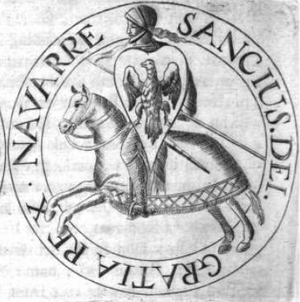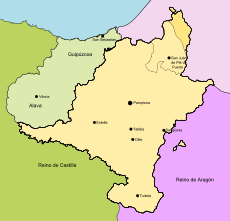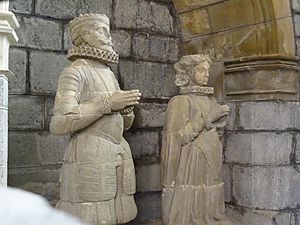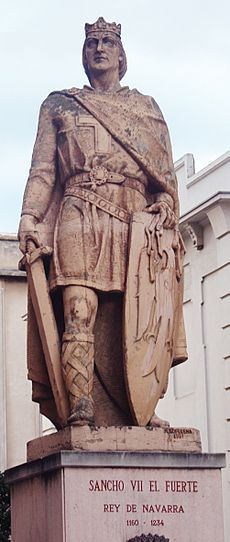Sancho VII of Navarre facts for kids
Quick facts for kids Sancho VII |
|
|---|---|

Sancho's seal
|
|
| King of Navarre | |
| Tenure | 1194–1234 |
| Predecessor | Sancho VI |
| Successor | Theobald I |
| Born | c. 1157 |
| Died | 7 April 1234 Tudela |
| Spouse | Constance of Toulouse |
| House | House of Jiménez |
| Father | Sancho VI of Navarre |
| Mother | Sancha of Castile |
| Religion | Catholicism |
Sancho VII (born around 1157, died April 7, 1234) was known as the Strong. He was the King of Navarre from 1194 until his death. Sancho VII was the son of Sancho VI. He was the second king to use the title King of Navarre.
Sancho VII was the first to use the famous chains of Navarre as his symbol. This symbol later became the main one for Navarre. He was also the last king from the Jiménez dynasty, a family that had ruled Navarre since the 800s.
Contents
Early Life and Family
Sancho was likely the oldest child of Sancho VI and Sancha. He was probably born in Tudela around 1157.
His younger sister, Berengaria, married Richard I of England in 1191. This wedding happened on the island of Cyprus. They were on their way to the Holy Land for the Third Crusade.
Sancho's Friendship with Richard I
Sancho and King Richard were said to be good friends and allies. Even before the marriage, they were close. When Richard was captured in Germany, the French took over some of his lands.
In 1194, Richard returned to his lands. Sancho's knights were helping him attack a castle. But Sancho had to go back to Navarre when his father died. He was crowned king in Pamplona on August 15, 1194.
Sancho's Time as King
Sancho arrived late to the Battle of Alarcos in 1195. This caused problems with Alfonso VIII of Castile. Sancho then attacked areas like Soria and Almazán. Eventually, they made peace with the Treaty of Tarazona.
Sancho also led trips against areas like Murcia and Andalusia. Between 1198 and 1200, he even went to Africa. He might have been helping the Almohads to get their support against Castile.
Losing Land to Castile
While Sancho was away, Alfonso VIII of Castile and Peter II of Aragon attacked Navarre. Navarre lost areas like Álava, Guipúzcoa, and Biscay to Castile. These losses were confirmed by a treaty in 1207.
Sancho's leadership was very important in the Battle of Las Navas de Tolosa in 1212. In this battle, Christian forces from Navarre, Castile, Portugal, and Aragon joined together. They defeated the forces of the Almohad leader, Muhammad an-Nasir.
Sancho's soldiers famously cut the chains that protected the enemy leader's tent. Because of this brave act, many believe the chains became the symbol of Navarre. They replaced the old symbol on the Navarrese coat of arms.
Relations with Other Kingdoms
Sancho got along better with countries north of the Pyrenees mountains. Several areas there became his allies. He also made agreements with King John of England and the kings of Aragon.
In 1231, he signed a treaty with James I of Aragon in Tudela. This treaty said that whoever lived longer would inherit the other's kingdom. However, the treaty was never fully completed.
Sancho also continued building a new cathedral in Pamplona. His father had started it, and his successor finished it. He is also credited with building a Gothic bridge over the Ebro river.
Family and Successor
Sancho VII was married twice. His first wife was Constance of Toulouse, whom he married in 1195. He ended their marriage a few years later. His second wife's identity is not clear. Some say she was Clemence, a daughter of Frederick I, Holy Roman Emperor. Others say she was the daughter of Yusuf II, Almohad caliph, an emir from Morocco.
Sancho VII did not have any known children with either wife. This meant he had no direct heir.
Later Years and Death
Sancho became very ill with a painful leg problem. He became very heavy and was ashamed of his condition. He retired to his castle in Tudela. His youngest sister, Blanche, came to manage the kingdom until she died in 1229.
His oldest sister, Berengaria, Queen of England, died in 1230. This left Sancho as the only living child of Sancho VI. When he died in Tudela, likely from his leg problems, his nephew Theobald IV of Champagne became the new king. Theobald was Blanche's son.
Sancho's Legacy
Sancho VII left Navarre with a lot of money and good roads. During his time, Navarre was known for its advanced human rights. The Jewish community there had a very good standing, better than in many other Christian parts of Europe. This was thanks to the Jiménez royal family, who had worked on this for centuries.
Sancho was first buried in the church of San Nicolás. Later, his remains were moved to Roncesvalles. His body was studied by a doctor named Luis del Campo. The doctor found that Sancho was very tall, about 2.20 meters (7 feet 3 inches). This tall height might be why he was called "the Strong."
Images for kids
-
Seal of Sancho VII the Strong
See also
 In Spanish: Sancho VII de Navarra para niños
In Spanish: Sancho VII de Navarra para niños





